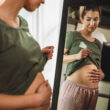Increasingly, women are turning to fertility awareness methods (FAMs) not just for pregnancy prevention, but specifically as health monitoring tools. Unfortunately, many women first encounter FAMs—and an in-depth understanding of how the female body is designed—only in their late twenties, early thirties, or beyond. Virtually all express a version of the same sentiment: Why wasn’t I taught this earlier?
Moms of teenage girls may further wonder, what and how should I teach my daughter about her cycles, fertility, and sexuality? In The Happy Girl’s Guide to Being Whole: What You Never Knew about Your Natural Body, a new book published by Lumen Press, seasoned Women’s Health Nurse Practitioner Teresa Kenney is on a mission to teach young women everything they should be taught in sex-ed (but often, are not)—most especially about their menstrual cycles and hormonal health [1].
Kenney opens the book with a manifesto of sorts, advocating for an understanding of the female body, and feminine fertility in particular, that contrasts starkly with the predominant mainstream narrative of fertility as a burden and relevant only to women seeking to conceive. Kenney writes:
“Instead of a narrative that tells women they must alter or suppress their natural feminine design in order to be happy and successful, we should create a culture that cultivates their feminine gifts, and a society that seeks to support them to thrive and remain whole… All women deserve to understand they were made good. To fully understand our bodies and hormonal gifts is true empowerment. It is time to embrace our menstrual cycles and procreative powers as the amazing gifts they are. These gifts should be respected, nurtured, and celebrated in our society in a way that helps women utilize them for the good of themselves, the good of their families, and the good of humanity.”
(Kenney, 10)
Teresa Kenney has over two decades of experience as a Women’s Health Nurse Practitioner, and she spent many of those years working for the St. Paul VI Institute where NaProTechnology was developed. She is also the co-founder of The Hormone Genius podcast, the mission of which is “to inspire, educate, and empower women across the world to become the geniuses of their own hormones in order to see the truth and dignity of their feminine design.”
Who is the intended audience of The Happy Girl’s Guide to Being Whole?
The Happy Girl’s Guide is addressed to high school and college-age women (the back of the book reads “Intended for ages 16-24”), though arguably any woman could benefit from the content covered within. The book is peppered with “Case Files” stories from teenage and twenty-somethings (with pseudonyms) whom Kenney has cared for throughout the years. Sections on relationship health and self-care are geared specifically to the teen and twenty-something demographic.
While the content directly addresses young women, this book would also make great study material for moms to read through together with their daughters. Notably, references to sex are biologically accurate without veering into titillation.
What are the main content areas of The Happy Girl’s Guide?
At just 137 pages of content (not including the resources and reference sections), The Happy Girl’s Guide is a very readable, “mini-textbook” of sorts. Main content areas include the anatomy of the male and female reproductive systems, in-depth explanation of his and hers hormones (including a fascinating lesson on the hormones released in both genders during sex), what’s normal and what’s not when it comes to periods and menstrual cycles, an intro to FAMs, and the key risks of each type of birth control, all masterfully presented in accessible language.
Strengths of The Happy Girl’s Guide?
There is much to love about The Happy Girl’s Guide. Visually appealing graphic design significantly enhances readability throughout the book, most especially in the section on the four phases of the female menstrual cycle. My favorite graphic was a brilliant original depiction showing what simultaneously goes on in the cervix, the uterus, and with the four main female hormones during each cycle phase. My favorite content includes why ovulation is a fifth vital sign, indicating both reproductive health and overall health in the body, and why ovulation (rather than menstruation) is the “main event” of the female cycle.
Importantly, the book provides answers to the common questions girls and young women have around their cycles and fertility, like how much (and how many days of) bleeding is normal, how long a normal cycle is from beginning to end (and what a too long or too short cycle could mean), whether pregnancy is always possible for women (i.e. whether women are always fertile), whether birth control is the best or only option for common reproductive problems like polycystic ovary syndrome (PCOS), irregular cycles, heavy bleeding, and more.
There’s even an insightful interview between Kenney and Dr. Marguerite Duane, founder of FACTS, that educates young women on how to approach their doctors about their desire to get off the Pill or utilize a FAM (which the book refers to as Natural Fertility Methods) for health monitoring, and even how to know when it’s time to seek a different provider (hint: if your doctor insists that FAMs are really just the rhythm method and won’t listen when you express your desire to learn more about your body through a FAM, it’s time).
Limitations or blindspots
I wish I’d found an index at the back of the book, especially one formatted to connect readers to specific page numbers for the answers to the reproductive health questions girls and young women are most commonly Google searching. I also would have liked the Self-Care section—which importantly addresses how young women can optimize their hormonal health through diet, supplements, exercise, sleep, cycle charting, and more—to include information on cycle syncing, which facilitates body literacy and self acceptance.
How practical are the author’s suggestions for the average woman?
Kenney’s down-to-earth tone and straightforward explanations lend themselves easily to manageable action steps for her intended audience of teens and twenty-somethings, as well as adult women in general. The basics of cycle and hormonal health she shares in the Guide are a solid launching point for young women to start tracking their cycles and signs of fertility, especially for those who want to take their personal health data to a trained restorative reproductive medicine (RRM) provider to work up reproductive issues. Certainly, healthcare deserts for RRM providers exist in many parts of the country, but fortunately telehealth is making Creighton, Marquette, FEMM, and other FAM instructors and healthcare providers accessible like never before.
As for how well the book’s content lives up to its promise of assisting girls and young women to become “happy” and “whole,” the Guide makes a strong case for why gaining body literacy through learning fertility awareness (and, when appropriate, using that knowledge to identify root causes for cycle issues) is a major component of overall female wellness.
The verdict: To buy, borrow, or skip The Happy Girl’s Guide to Being Whole altogether?
I bought copies of this book for myself, my mom, my sister, and my sister-in-law. Since we are each geographically spaced out across the state and even country, my hope is that each woman makes The Happy Girl’s Guide to Being Whole into a literary version of the jeans from Sisterhood of the Traveling Pants, spreading the good news amongst female friends and relatives. This book deserves a place on your bookshelf.
References:
Kenney, Teresa. The Happy Girl’s Guide to Being Whole: What You Never Knew About Your Natural Body. Lumen Press: 2022 (2nd printing).
Additional Reading:
Natural Womanhood Book Review: In the Flo by Alisa Vitti
Teens and irregular cycles: what’s normal- and what’s not (Part I)
Teens and irregular cycles: what’s normal- and what’s not (Part II)
Busting the 4 biggest myths about teens and fertility education
Should you put your teenage daughter on hormonal birth control?
Teaching your daughter about periods: why you don’t need to give her “the talk”
Why I’m teaching my daughters how to chart their menstrual cycles







